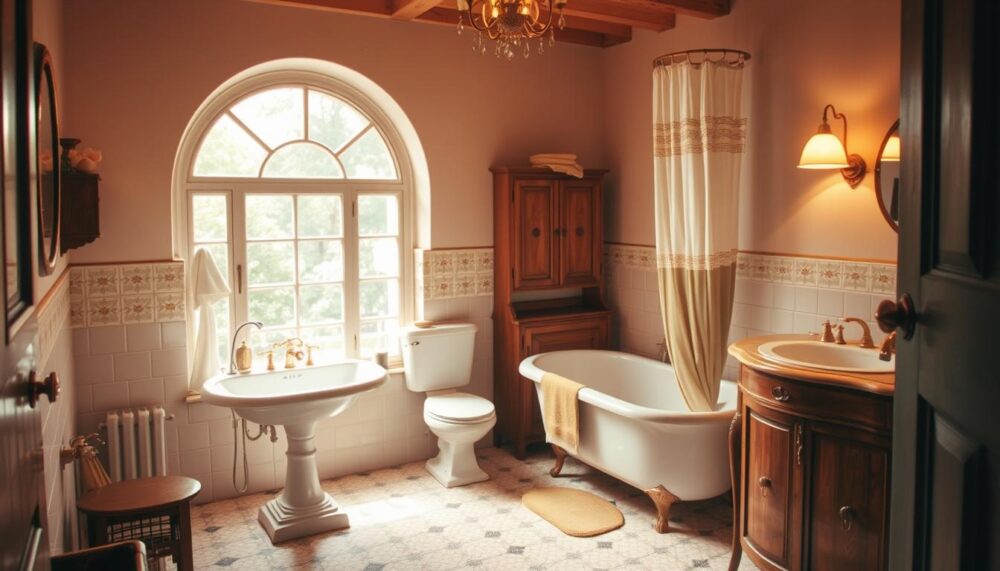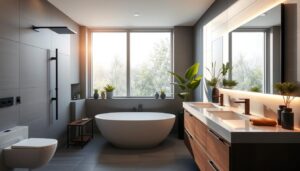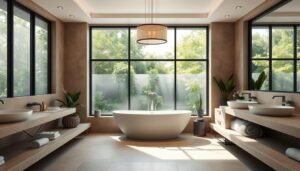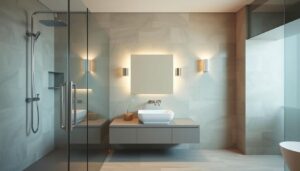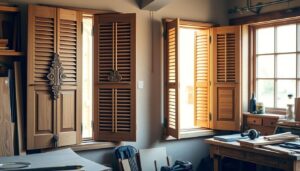Restoring a heritage home’s charm while adding modern comforts is no small feat. Our nine-month project transformed a dated, dysfunctional space into a functional yet characterful retreat. The original features, like the deep soaking tub, clashed with awkward 1970s additions—think mismatched tiles and a poorly placed mirror.
Water damage near the timber window and an impractical towel rail were just the start. Even Frank the Fiddle Leaf Fig seemed to protest the apricot-and-pink colour scheme! Balancing design needs with preservation required careful planning.
This guide shares how we tackled quirks like storage woes and rot—keeping the soul of the space intact. Whether you’re working with a similar era or just love vintage flair, these solutions adapt to any home.
Key Takeaways
- Blending heritage charm with modern functionality takes time and patience.
- Addressing structural issues, like water damage, is crucial in older properties.
- Original features, such as freestanding tubs, can anchor the design.
- Colour schemes and layouts should enhance, not fight, the space’s character.
- Practical storage solutions maintain aesthetics without sacrificing usability.
The Starting Point: Assessing Our 1930s Bathroom’s Quirks
Every heritage home hides a story—ours began with a shower head pointed at a timber window. The result? Rotting wood and winter showers al fresco. Like many period properties, ours had layers of odd updates. A 1970s revamp left apricot tiles clashing with pink grout, while the mirror hung off-centre like a wonky painting.
Identifying the Problems: From Water Rot to Awkward Layouts
The window wasn’t the only casualty. A towel rail dangled into the tub, and power points sat mid-wall—useless for hairdryers. The door swung awkwardly, eating into precious storage space. Yet, some original gems endured: the Ideal Standard basin and Laminex surfaces stood the test of time.
| Original Features | 1970s Additions |
|---|---|
| Durable Laminex surfaces | Mismatched floor tiles |
| Freestanding tub | Apricot joinery |
| Timber-framed window | Off-centre mirror |
Frank the Fiddle Leaf Fig and Other Quirky Features
Amid the chaos, Frank the plant became our mascot. He survived relocations and Canberra’s frosts, softening the room’s hard edges. His resilience mirrored ours—especially when we decluttered 50% of the cupboards. As one builder quipped:
“Some things belong in a museum. Others, like apricot tiles, belong in the skip.”
The lesson? Respect the house’s bones, but don’t shy from fixing its quirks.
Design Decisions: Balancing Heritage Charm and Modern Functionality
Creating a space that honours the past while meeting today’s needs requires thoughtful choices. Our goal was to blend vintage elegance with practical updates, ensuring every element served a purpose. From fixtures to finishes, each decision aimed to enhance both look and usability.
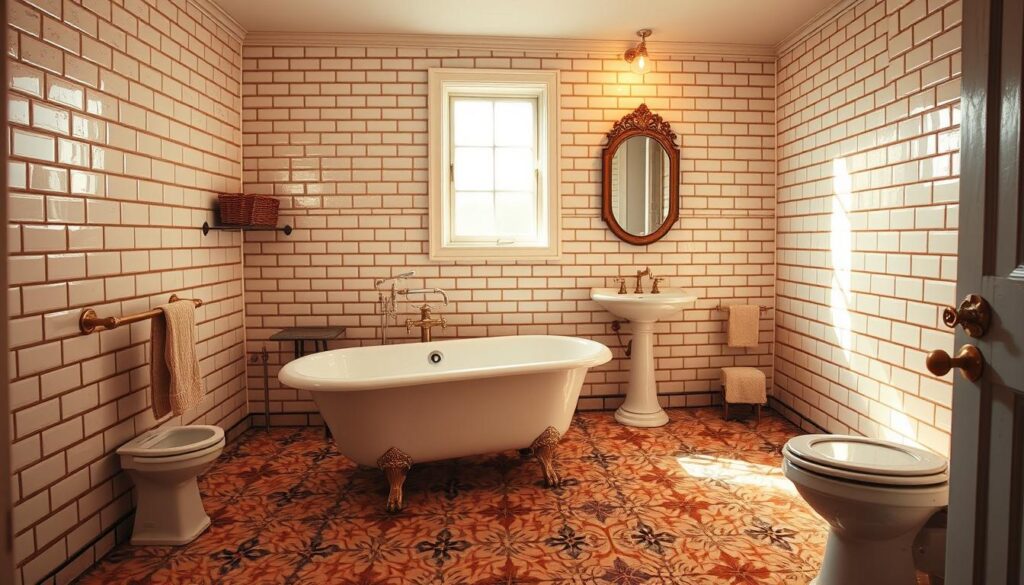
To Bathe or Not to Bathe? Choosing Between a Tub and Walk-In Shower
The debate between keeping the original bathtub or opting for a shower was tricky. While the tub added character, a walk-in shower suited daily use better. We chose Option B—a spacious, arched cubicle—despite the extra plumbing work.
| Option A (Keep Tub) | Option B (Walk-In Shower) |
|---|---|
| Preserves original charm | Better for accessibility |
| Lower upfront cost | Easier to maintain |
| Limited functionality | Higher installation cost |
Materials and Aesthetic Choices
Stone architraves and small, grippy floor tiles nodded to the 1930s Spanish Colonial style. A mirrored niche added storage without cluttering the space. For inspiration, we looked to high-end projects like Amy’s Tudor remodel, which used Ann Sacks tiles and honed marble.
Maximising Space: Door Swings and Storage Solutions
Adjusting the door swing freed up room for a wider vanity. We relocated the toilet and added a shaving cabinet, making the most of every inch. Heated floors provided modern comfort without disrupting the house’s heritage feel.
- Changed door swing direction to improve flow
- Added mirrored cabinets for hidden storage
- Used classic floor tiles for safety and style
Every choice, from the design to the fixtures, aimed to respect the past while embracing modern living. The result? A space that feels timeless yet effortlessly functional.
The Renovation Process: Challenges and Solutions
Navigating a period property’s limitations taught us invaluable problem-solving lessons. From hidden structural issues to supplier delays, each hurdle demanded creative thinking. Here’s how we turned obstacles into opportunities.
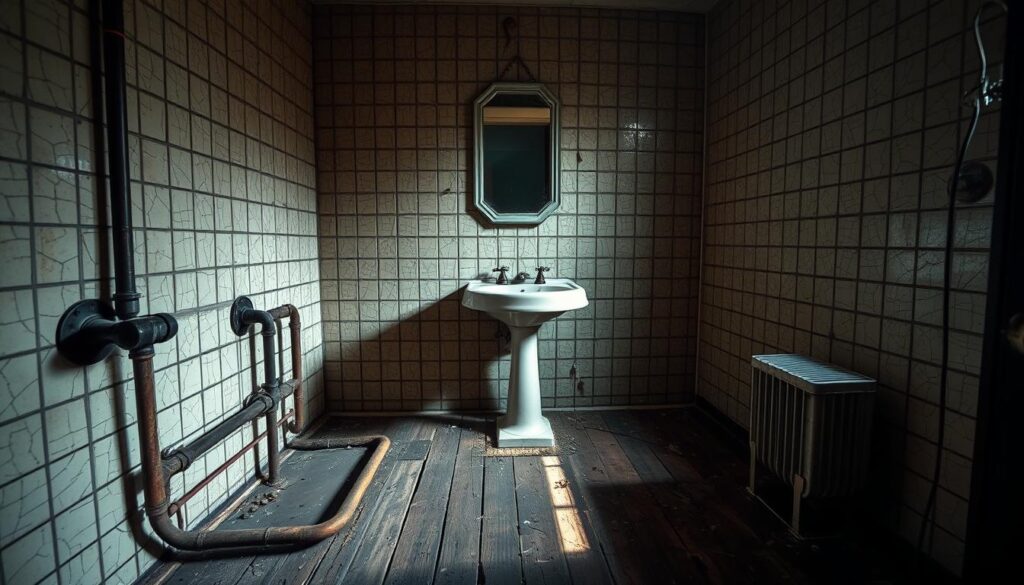
Working with Heritage Constraints
Modernising plumbing in a 1930s home required careful planning. We extended walls to conceal pipes, preserving original brickwork. Heritage rules meant no drilling into certain surfaces—so we built new stud frames instead.
The toilet relocation was trickier. Original floor joists dictated its new position, adding days to the project. As our builder noted:
“Older homes fight back when you move things. Patience pays off.”
| Challenge | Solution |
|---|---|
| Concealing pipes | Extended walls with false panels |
| Heritage brickwork | Non-invasive mounting systems |
| Original joists | Custom plumbing routes |
Unexpected Delays and Workarounds
Custom glass for the arched shower took six weeks—double the estimated time. Meanwhile, tree roots invaded the drains (a nod to Amy’s ordeal). We tackled backups with hydro-jetting and root barriers.
Builder confusion over the shower’s curve led to sketches pinned on-site. Visual aids bridged the gap between our vision and their expertise. Key takeaways:
- Buffer time for bespoke items (windows, tiles).
- Plan for 10–15% budget overruns on older properties.
- Sketch designs if tradies lack period experience.
Despite the hiccups, the project reaffirmed a truth: heritage homes reward those who respect their quirks.
Conclusion: Lessons Learned from Our 1930s Bathroom Transformation
The key lesson? Design for how you live, not just how it looks. We swapped the tub for a shower—a choice that made daily routines smoother. Practicality beats hypothetical “what-ifs” every time.
A detailed plan saved us from mid-project chaos. From tiles to layouts, every decision was mapped early. This kept the home’s heritage soul intact while adding modern ease.
Blending old and new takes patience. Original basins paired with heated floors? Worth the effort. For fellow renovators, invest in organisers—they’re lifesavers.
Now, the space feels timeless. It’s proof that with thoughtful choices, you can honour the past without living in it.
FAQ
What are common issues in a 1930s bathroom?
Older bathrooms often face problems like water damage, awkward layouts, and outdated plumbing. Heritage features, such as original tiles or fixtures, may need careful restoration.
Should I keep a bathtub or switch to a walk-in shower?
It depends on space and preference. A tub suits those who enjoy baths, while a walk-in shower offers modern convenience. Consider the room’s dimensions before deciding.
How can I blend vintage charm with modern functionality?
Use heritage-inspired tiles, classic brass fittings, and period-appropriate colours. Pair them with contemporary storage solutions and efficient plumbing for the best of both worlds.
What’s the best way to maximise space in a small bathroom?
Opt for wall-mounted storage, sliding doors, or recessed shelving. A well-planned layout can make even compact spaces feel open and practical.
How do I handle unexpected delays during renovation?
Plan for extra time and budget. Issues like hidden pipe damage or sourcing authentic materials can slow progress, so flexibility is key.
Can I modernise plumbing without losing original features?
Yes! Skilled plumbers can upgrade pipes and fittings while preserving heritage elements. Concealed plumbing behind walls or under floors helps maintain the classic look.

